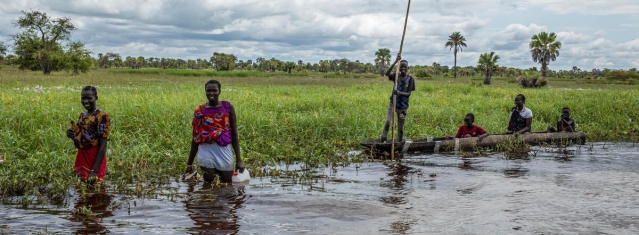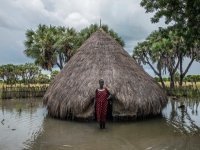News
Hunger and malnutrition being driven by climate crisis & conflict in South Sudan
UN WFP Press Release

(Source: WFP)
ARAC International Strategic Communications -
The proportion of people facing severe acute food insecurity is at the highest level ever, surpassing levels seen even during the conflicts in 2013 and 2016.
Juba – Hunger and malnutrition are on the rise across the flood, drought, and conflict-affected areas of South Sudan, with some communities likely to face starvation if humanitarian assistance is not sustained and climate adaptation measures are not scaled-up, the United Nations warned today.
Juba – Hunger and malnutrition are on the rise across the flood, drought, and conflict-affected areas of South Sudan, with some communities likely to face starvation if humanitarian assistance is not sustained and climate adaptation measures are not scaled-up, the United Nations warned today.
The latest Integrated Food Security Phase Classification (IPC), released today, shows about two-thirds of the South Sudanese population (7.76 million people) are likely to face acute food insecurity during the April-July 2023 lean season while 1.4 million children will be malnourished.
The Food and Agriculture Organization of the United Nations (FAO), the United Nations Children’s Fund (UNICEF), and the United Nations World Food Programme (WFP) warn that the proportion of people facing high levels of food insecurity (IPC Phase 3 [crisis] or above) and malnourishment is at the highest level ever, surpassing levels seen even during the conflict in 2013 and 2016. The decline in food security and high prevalence of malnutrition is linked to a combination of conflict, poor macroeconomic conditions, extreme climate events, and spiralling costs of food and fuel. At the same time, there has been a decline in funding for humanitarian programmes despite the steady rise in humanitarian needs.
The Food and Agriculture Organization of the United Nations (FAO), the United Nations Children’s Fund (UNICEF), and the United Nations World Food Programme (WFP) warn that the proportion of people facing high levels of food insecurity (IPC Phase 3 [crisis] or above) and malnourishment is at the highest level ever, surpassing levels seen even during the conflict in 2013 and 2016. The decline in food security and high prevalence of malnutrition is linked to a combination of conflict, poor macroeconomic conditions, extreme climate events, and spiralling costs of food and fuel. At the same time, there has been a decline in funding for humanitarian programmes despite the steady rise in humanitarian needs.
“We’ve been in famine prevention mode all year and have staved off the worst outcomes, but this is not enough,” warned Makena Walker, Acting Country Director for WFP in South Sudan. “South Sudan is on the frontlines of the climate crisis and day in, day out families are losing their homes, cattle, fields and hope to extreme weather. Without humanitarian food assistance, millions more will find themselves in an increasingly dire situation and unable to provide even the most basic food for their families.”
The unprecedented, multi-year flood sweeping the country is exacerbating already high levels of hunger caused by ongoing conflict and the global food crisis. Central parts of the country, which are the most heavily impacted by multiyear flooding, are the areas with the highest levels of food insecurity.
The unprecedented, multi-year flood sweeping the country is exacerbating already high levels of hunger caused by ongoing conflict and the global food crisis. Central parts of the country, which are the most heavily impacted by multiyear flooding, are the areas with the highest levels of food insecurity.
“Livelihood support is particularly needed to facilitate South Sudan’s self-reliance in food production. We know the potential exists as about 840 000 tonnes of cereals were produced in 2021, during a difficult year with climate change, floods, conflict and other factors. With the current cereal deficit of 541 000 tonnes, urgent investment in rural livelihoods is needed to increase production and self-sufficiency,” said Meshack Malo, FAO Representative in South Sudan.
While there have been marginal improvements in food security across some parts of the country, the nutrition crisis across South Sudan is deepening. All counties except one are showing a deterioration in their nutrition situation through June 2023, including 44 counties where the situation is deemed critical.
While there have been marginal improvements in food security across some parts of the country, the nutrition crisis across South Sudan is deepening. All counties except one are showing a deterioration in their nutrition situation through June 2023, including 44 counties where the situation is deemed critical.
“Over the past three years, floods have dramatically affected an increasing number of people across South Sudan,” said UNICEF Acting Representative in South Sudan Jesper Moller. “Among those impacted, we find a growing number of food-insecure and malnourished children, which the international community cannot ignore. To effectively protect children from the effects of climate change, we must ensure we reach the most vulnerable children with an essential package of multi-sectoral social service interventions.”
“The IPC report is the product of months of data collection and analysis, with participation from Government, UN agencies, NGOs, and other partners,” added Sara Beysolow Nyanti, United Nations Resident and Humanitarian Coordinator for South Sudan. "Quality data like this is critical to formulating humanitarian response plans to help meet the needs of people in the country, and these figures show the people of South Sudan need support more than ever. It’s vital we receive commitments from donors for 2023 so we can prevent a worsening of the humanitarian situation across the country.”
Resourcing for the 2023 humanitarian response in South Sudan is urgently needed within the next few months or agencies will be unable to preposition humanitarian assistance in time for the next year, leaving millions of families at risk of spiralling deeper into hunger.
Resourcing for the 2023 humanitarian response in South Sudan is urgently needed within the next few months or agencies will be unable to preposition humanitarian assistance in time for the next year, leaving millions of families at risk of spiralling deeper into hunger.
There will be 7.76 million people facing severe acute food insecurity during the April-July 2023 lean season. This includes a projected 2.9 million on the brink of starvation (IPC Phase 4) and another 43,000 who are expected to be living in Catastrophe (IPC Phase 5) acute food insecurity. There will be 47 counties with the majority of the population in Emergency (IPC Phase 4) during the 2023 lean season.
In Jonglei and Unity states, 74 and 77 percent of their populations, respectively, are likely to be in IPC Phase 3 (Crisis) or above, with pockets of populations experiencing IPC Phase 5 (Catastrophe) acute food insecurity for the period of April to July 2023.
Meanwhile, Eastern Equatoria in the southeast of the country has seen the most significant deterioration in food security across South Sudan’s counties impacted by the Horn of Africa drought. Dry conditions have taken hold across the greater Kapoeta region and decimated livelihoods as crops and cattle perish.
In Jonglei and Unity states, 74 and 77 percent of their populations, respectively, are likely to be in IPC Phase 3 (Crisis) or above, with pockets of populations experiencing IPC Phase 5 (Catastrophe) acute food insecurity for the period of April to July 2023.
Meanwhile, Eastern Equatoria in the southeast of the country has seen the most significant deterioration in food security across South Sudan’s counties impacted by the Horn of Africa drought. Dry conditions have taken hold across the greater Kapoeta region and decimated livelihoods as crops and cattle perish.
These IPC numbers are based on the assumption that people will continue to receive humanitarian food assistance through the 2023 lean season. Without this food assistance, the figures would be significantly worse. It should also be noted that the county of Panyikang in Upper Nile State, an area with historically high levels of food insecurity, could not be surveyed due to insecurity.
The United Nations World Food Programme is the world’s largest humanitarian organization, saving lives in emergencies and using food assistance to build a pathway to peace, stability and prosperity for people recovering from conflict, disasters and the impact of climate change.
The Food and Agriculture Organization (FAO) is a specialized agency of the United Nations that leads international efforts to defeat hunger. Our goal is to achieve food security for all and make sure that people have regular access to enough high-quality food to lead active, healthy lives.
The United Nations World Food Programme is the world’s largest humanitarian organization, saving lives in emergencies and using food assistance to build a pathway to peace, stability and prosperity for people recovering from conflict, disasters and the impact of climate change.
The Food and Agriculture Organization (FAO) is a specialized agency of the United Nations that leads international efforts to defeat hunger. Our goal is to achieve food security for all and make sure that people have regular access to enough high-quality food to lead active, healthy lives.
UNICEF promotes the rights and wellbeing of every child, in everything we do. Together with our partners, we work in 190 countries and territories to translate that commitment into practical action, focusing special effort on reaching the most vulnerable and excluded children, to the benefit of all children, everywhere.
Follow us on Twitter @wfp_SouthSudan @FAOSouthSudan @unicefssudan
Source: United Nations World Food Programme
CONTACT
FAO – Tanya Birkbeck,
tanya.birkbeck@fao.org,
+211 920 490 149
UNICEF – Richard Ruati
rruati@unicef.org,
+211 921 359 578
WFP – Gemma Snowdon,
gemma.snowdon@wfp.org,
+211 925 430 085
Follow us on Twitter @wfp_SouthSudan @FAOSouthSudan @unicefssudan
Source: United Nations World Food Programme
CONTACT
FAO – Tanya Birkbeck,
tanya.birkbeck@fao.org,
+211 920 490 149
UNICEF – Richard Ruati
rruati@unicef.org,
+211 921 359 578
WFP – Gemma Snowdon,
gemma.snowdon@wfp.org,
+211 925 430 085
____________________________________________________________
Office of Strategic Communications & Analysis
ARAC International, Global Security Analyst | Human Rights Consultant
Certified by the U.S. Institute for Diplomacy and Human Rights
Institute for Economics and Peace Ambassador
https:/iep.arac-international.org
Office of Strategic Communications & Analysis
ARAC International, Global Security Analyst | Human Rights Consultant
Certified by the U.S. Institute for Diplomacy and Human Rights
Institute for Economics and Peace Ambassador
https:/iep.arac-international.org
more information: https://www.arac-international.org/2022/11/hunger-and-malnutrition-being-driven-by.html
Liability for this article lies with the author, who also holds the copyright. Editorial content from USPA may be quoted on other websites as long as the quote comprises no more than 5% of the entire text, is marked as such and the source is named (via hyperlink).






